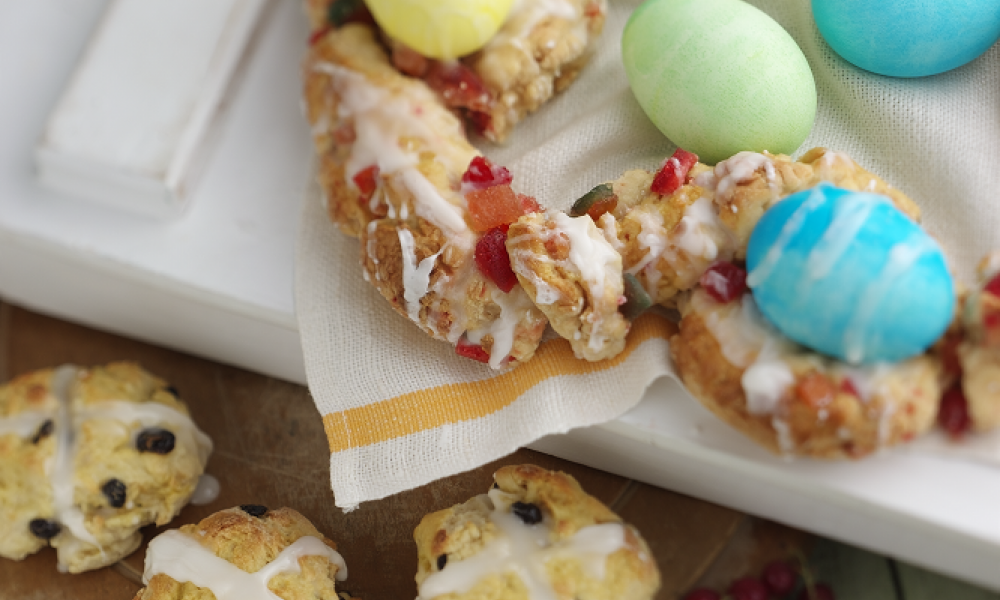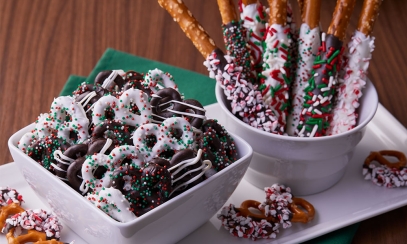
Hot Cross Buns and Easter Egg Bread - Easter Favorites
Hot cross buns! Hot cross buns!
One a penny,
Two a penny,
Hot cross buns!
If you have no daughters,
Pray give them to your sons!
One a penny,
Two a penny,
Hot cross buns!
Remember this nursery rhyme? Taught to countless generations of school children in America and abroad, it celebrates one of the most anticipated foods of the Lenten season.
Hot cross buns, a traditional Good Friday favorite in England, are thought to have originated there in pre-Christian times. Sacred cakes called “bouns” were baked in preparation for the festival honoring “Eostre,” the goddess of spring. (Can you guess how the words “bun” and “Easter” evolved?) And the cross cut into the buns’ tops represented the moon – the heavenly body associated with the goddess – and its four quarters.
It’s said that the first Christian missionaries tried to stop the people from consuming the buns because they were associated with pagan rituals. Failing at that, the missionaries gave the sweet treats a Christian meaning by blessing them and likening the markings to the cross of Christ.
Over the centuries, many superstitions sprang up around the buns. Some said a hot cross bun kept from one Good Friday to the next would bring good luck or protect a person against being shipwrecked. Or that hanging a bun over the chimneypiece ensured that all bread baked there would be perfect.
To bake a perfect pan of hot cross buns all you need is the recipe below. (By the way, the word “hot” refers to the temperature of the buns, not the spiciness!) Following the hot cross buns, you will find another popular Easter treat – braided bread baked around five colored eggs. This delicacy is made even more mouthwatering by the addition of candied fruit, almonds and anise seed.
Hot Cross Bun
Yield: 2 1/2 dozen
2 packages active dry yeast (1/4 oz. each)
1 1/2 cups warm skim milk
1/2 cup sugar
1/4 cup softened butter or margarine
1 Tsp vanilla
1 Tsp salt
1/2 Tsp ground nutmeg
6 1/2 to 7 cups all-purpose flour
4 eggs
1 cup dried currants (the traditional English choice) or raisins
Glaze:
2 Tblsp water
1 egg yolk
Icing:
1 cup confectioner’s sugar
4 Tsp milk or cream
Dash of salt
1/4 Tsp vanilla
Heat the skim milk to 110-115°. In a large mixing bowl, dissolve the yeast in the warm milk. Add the sugar, butter or margarine, vanilla, salt, nutmeg, and 3 cups of the flour. Beat until smooth. Add the eggs, one at a time, beating the mixture well after each addition. Stir in the dried fruit and enough flour to make a soft dough.
Turn out onto a floured surface and knead until smooth and elastic, about 6 to 8 minutes. Place in a greased bowl and turn over to grease the top. Cover with a damp towel or plastic wrap and let rise in a warm place until doubled in size (about 1 hour).
Punch the dough down and shape into 30 balls. Place on lightly greased baking sheets. Cover and let rise until doubled (about 30 minutes). Using a sharp knife, cut a cross on the top of each roll. Beat the water and egg yolk together and brush over rolls. (You’ll probably have more than you need; you may discard the unused glaze.) Bake at 375° for 12 to 15 minutes.
While the buns are baking, make the icing by combining its four ingredients. Stir until smooth, adjusting the sugar and milk to make a mixture that flows easily.
When the rolls are done, remove from the oven and cool on wire racks. Drizzle icing over the top of each roll following the lines of the cut cross. Serve while the rolls are still warm.
Easter Egg Bread
Yield: 1 ring
3 to 3 1/2 cups all-purpose flour
1/4 cup granulated sugar
1 package active dry yeast
1 Tsp salt
2/3 cup warm milk
2 Tblsp softened butter or margarine
2 eggs (plus 5 eggs for garnish)
1/2 cup chopped candied fruit
1/4 cup chopped blanched almonds
1/2 Tsp anise seed
In a large mixing bowl, combine 1 cup of flour, sugar, yeast, and salt. Add the milk (warmed to 110-115°) and butter or margarine and beat with an electric mixer on medium for 2 minutes. Add the eggs and a 1/2 cup of flour and beat on high for another 2 minutes.
Stir in the fruit, nuts and anise seed, mixing well. Stir in enough remaining flour to form a soft dough. Turn out onto a lightly floured surface and knead until smooth and elastic (about 6 to 8 minutes). Place in a greased bowl, turning once to grease the top. Cover with a damp cloth or plastic wrap and let rise in a warm place until doubled in size (about 1 hour).
About 30 minutes before the dough has finished rising, color the 5 eggs (leave them uncooked!) with nontoxic dyes. When dry, lightly rub them with vegetable oil.
Punch down the risen dough. Divide in half. Roll each half into a 24-inch rope. On a greased baking sheet, loosely twist the two ropes together. Form into a ring and pinch the ends together. Gently split the ropes and tuck the 5 colored, uncooked eggs into the openings. Cover and let rise again until doubled (about 30 minutes). Bake in a 350° oven for 30 to 35 minutes or until golden brown. Remove from the baking sheet and cool on a wire rack before serving.



